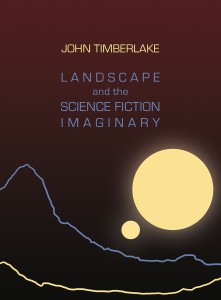Landscape and the Science Fiction Imaginary


Average rating: ![]()
| 0 | rating | |
| 0 | rating | |
| 0 | rating | |
| 0 | rating |
Your rating: -
Book Presentation:
There has been plenty of scholarship on science fiction over the decades, but it has left one crucial aspect of the genre all but unanalyzed: the visual. Ambitious and original, Landscape and the Science Fiction Imaginary corrects that oversight, making a powerful argument for science fiction as a visual cultural discourse. Taking influential historical works of visual art as starting points, along with illustrations, movie matte paintings, documentaries, artist’s impressions, and digital environments, John Timberlake focuses on the notion of science fiction as an “imaginary topos,” one that draws principally on the intersection between landscape and historical/prehistorical time. Richly illustrated, this book will appeal to scholars, students, and fans of science fiction and the remarkable visual culture that surrounds it.
Press Reviews:
"Offers valuable analyses of works of non-literary sf, and makes a strong case for their importance to our understanding of the development of the genre and its engagement with landscape. The works central to each chapter are carefully historicized, and broaden our view of the sf imaginary and its intersection with landscape in visual culture. . . . A welcome re-assessment of the importance of the visual and its intersection with wider culture."
Foundation: The International Review of Science Fiction
"Moving easily from ancient mythology to postmodern cinema, Timberlake examines how fluctuations in physical size influence social relations, yielding a tragic framework in which physical environments exhibit an 'elemental indifference' to human presence. . . . Such moves reveal the nuanced, and occasionally understated, methodology of Landscape and the Science Fiction Imaginary. Less a study of sf per se, it rather illuminates in sf a visual imperative that Timberlake argues is at work 'across the centuries,' connecting works as diverse as Goya’s painting and video games such as Metal Gear Solid. . . . The conceptual gravity of Timberlake’s study is undeniable, and his compelling readings make Landscape and the Science Fiction Imaginary a valuable contribution to the field of sf criticism and visual media theory."
Patrick Whitmarsh | Science Fiction Research Association Review
"Landscape and the Science Fiction Imaginary offers valuable, critical insights into some of the landscapes of sf and provide both background to them and methods to approach them critically, thus also contributing to fields such as literary geography and ecocriticism. Readers interested in the analysis of the visual aspect of landscape in sf or other genres, or in the development of the tropes of setting in sf, will find this book of interest."
Science Fiction Film and Television
"[Timberlake's] dense, high-theoretical answer of cosmic “landscaping” takes readers on an excursion from the Baroque French painter Nicolas Poussin, to the Spanish Romantic painter Francisco Goya, to the contemporary digital short-film director Keiichi Matsuda, to the 1970s-era paperback cover artist Chris Foss, to post-nuclear documentary photography Yosuke Yamahata, to the mid-century magazine illustrations of Chesley Bonestall, and onward and upward to other equally disparate, wide-ranging instances of sf visual art. . . . Timberlake also presents a thoughtful, consistent, and lucid investigation of a ritually overlooked topic, which deserves many plaudits for skillfully navigating uncharted waters. I heartily recommend this volume for scholars and students of visual culture, sf studies, literature, critical theory, and contemporary cultural studies."
Extrapolation
“Through its account of science fiction as a form of ‘alternate seeing’, ‘suppositional realism’, confrontation with the arche-fossils of pre-human landscapes, and utopic longing in the face the demise of traditional forms of futurism, this book reveals how varied and important the ‘science fiction imaginary’ is to the political, historical and scientific resources of literary, artistic and filmic form.”
John Roberts, University of Wolverhampton
See the publisher website: Intellect Books
> On a related topic:
Robots That Love (2025)
Artificial Amours in Myth, Folklore, Literature, Popular Culture and the Real World
Subject: Genre > Science Fiction
The Future Was Now (2025)
Madmen, Mavericks, and the Epic Sci-Fi Summer of 1982
Subject: Genre > Science Fiction
Feminist Posthumanism in Contemporary Science Fiction Film and Media (2025)
From Annihilation to High Life and Beyond
Dir. Julia A. Empey
Subject: Genre > Science Fiction
Societies in Space (2025)
Essays on the Civilized Frontier in Film and Television
Dir. Gary Westfahl
Subject: Genre > Science Fiction
The Science Fiction Film in Contemporary Hollywood (2025)
A Social Semiotics of Bodies and Worlds
Subject: Genre > Science Fiction
Amazing Worlds of Science Fiction and Science Fact (2025)
by Keith Cooper
Subject: Genre > Science Fiction
The New Routledge Companion to Science Fiction (2024)
Dir. Mark Bould, Andrew Butler and Sherryl Vint
Subject: Genre > Science Fiction
The Trans and Non-Binary Hero's Journey (2024)
Quests for Empowerment in Science Fiction and Fantasy
by Valerie Estelle Frankel and Dean Leetal
Subject: Genre > Science Fiction